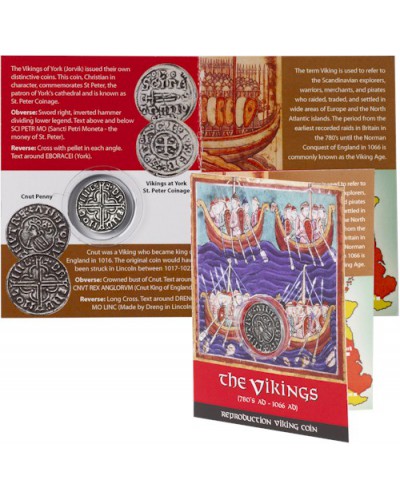Product Description: This reproduction Cnut Penny is moulded directly from an original coin and is made from lead-free pewter. The wallet type packaging has a hole on the front in which the coin is held in a clear blister. The coin pack has images of Vikings in ships on the front, the two coins in the collection inside, as well as additional Viking images. It has historical information about the coins and about the rise and fall of the Vikings.
Information: Cnut was a Viking who became king of England in 1016. The original penny coin would have been struck in Lincoln between 1017-1023. The obverse of the coin depicts the bust of Cnut and the reverse a long cross.
The term Viking is used to refer to the Scandinavian explorers, warriors, merchants, and pirates who raided, traded, and settled in wide areas of Europe and the North Atlantic islands. The period from the earliest recorded raids in Britain in 780's until the Norman Conquest of England in 1066 is commonly known as the Viking Age.
The Vikings voyaged far from their homes, driven by the lack of good farmland to seek new lands to settle and by the urge to plunder. Using their longships to travel by sea, the Vikings initially raided Britain, particularly monasteries, which were easy targets with great wealth. By the late 9th century, the Vikings had settled and gained control of two thirds of Britain, with Jorvik (York) the base for Viking kings and Viking trade.
In the early AD 1000s, the Saxon king Aethelred 'The Unready' paid Viking raiders to stop their attacks. This money was called 'Danegeld'. However, in 1013 Sweyn Forkbeard, King of Denmark, invaded England leaving his son Cnut king of England and part of the Viking empire.
In 1066 England was conquered by the Normans under William, The Conqueror. They took over all of England, and in 1069 burned Jorvik. This was the end of the Viking Age.
Tags: Cnut Penny, Coin Pack, Pewter, Viking

